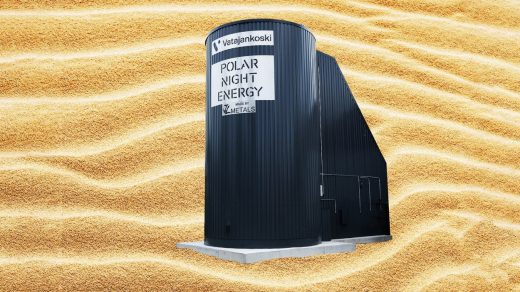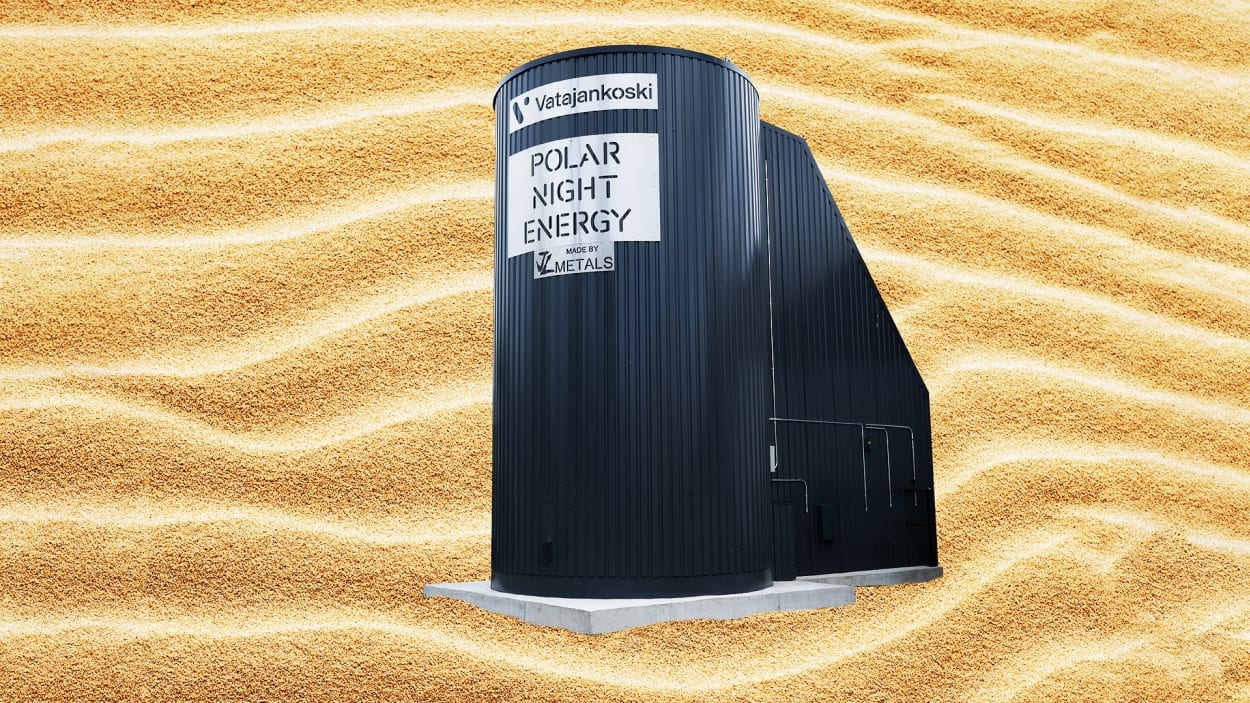This startup just built a giant battery out of sand
On the edge of a small town in Western Finland, a startup called Polar Night Energy worked with a local utility to pioneer something that doesn’t exist anywhere else in the world: a giant sand battery. It’s what it sounds like: A tower filled with 100 tons of sand, designed to be super-heated with renewable electricity that then can store the heat for months, so power generated in the summer could later be used to heat homes in the winter.
The main purpose of the design “is to enable the upscaling of solar and wind,” says Markku Ylönen, cofounder and CTO of the startup. As renewable energy grows, so does the mismatch between production and demand; solar and wind farms now often generate much more electricity than the grid needs, but only at specific moments. At other times, when the sun isn’t shining or the wind isn’t blowing, the grid has to turn to other sources. The energy could be stored in lithium-ion batteries, but they are still relatively expensive. Polar Night Energy isn’t solving the problem of how to store electricity cheaply, since it’s inefficient to turn electricity into heat and then back into electricity. But by storing renewably-powered heat long term, it’s helping reduce another source of emissions.
At factories, the sand batteries could help store heat for industrial processes that require high temperatures and currently run on fossil fuels. The sand can be heated to 400 degrees Celsius (752 Fahrenheit), and with some tweaks to the pipes and other materials in the system, it could store and provide heat up to 700 or 800 degrees Celsius. The basic approach is simple. Inside a strong container—either a silo with extra-thick walls, or an underground space, potentially built in an old mine—a giant pile of sand can be heated with hot air blowing through pipes. When the sand is extremely hot, it naturally retains the heat until it’s ready for use.
Sand is an ideal material for the purpose. “It’s something that’s available everywhere,” says Ylönen. “It’s cheap, and you can build large storage for scaling it up.” Other cheap materials can also store heat, like water, but sand has the advantage of being able to reach much higher temperatures. The company can also use the lowest grade of sand, which wouldn’t be used in the construction industry.
Future facilities might be located directly next to wind farms, but the first sand battery, in the Finnish town of Kankaanpää, connects directly to the grid, running when the electricity is cheapest (this also happens to be when the most renewable energy is being produced, although the first system isn’t running directly on renewables). The equipment is next to a data center, which produces waste heat. That heat is pumped into Polar Night Energy’s system, which then heats it up further. The heat can then flow into into the town’s district heating system, a network of pipes that sends heat into individual homes.
Since the storage can last for months, it could make use of solar energy generated on summer days to later provide winter heat. But Ylönen says the ideal use case in Finland is a shorter cycle that makes use of wind energy, which is more abundant in the winter. “With any battery technology or storage technology, the more you use it, the better the economics look like,” he says. “So an optimal period for us is something like two to three weeks of discharging and charging.”
The system is already competitive with gas, and the large-scale systems that the company plans to build next—100 times the size of the first silo—will be competitive with burning biomass, something that Finland currently does to produce much of its heat now. (Burning wood is technically carbon-neutral since trees take up carbon as they grow, but a better solution in a climate emergency is to stop burning anything.)
The company plans to soon raise more funding to expand, and is in discussions with other district heating managers in Finland and Sweden, and with industrial plants around the globe. Though the technology is patented, all of the parts are available off-the-shelf from manufacturers, so it’s possible to grow quickly. “Finland has to be the proving ground, since we’re building a physical product,” says Ylönen. “But we want to spread the technology around the world as fast as possible.”
Fast Company , Read Full Story
(24)



